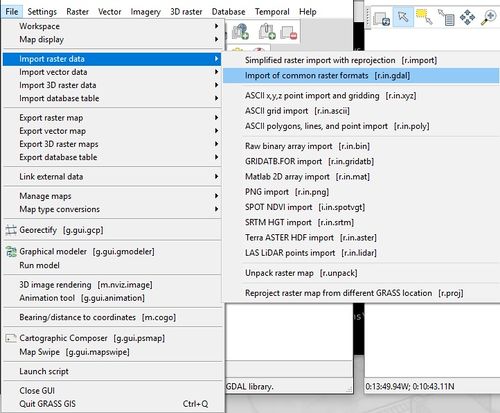Difference between revisions of "Fire spread through cost path analysis in QGIS GRASS"
ColtonMale (talk | contribs) |
ColtonMale (talk | contribs) |
||
| Line 116: | Line 116: | ||
|- |
|- |
||
|} |
|} |
||
| + | |||
<br> |
<br> |
||
Revision as of 19:34, 19 December 2017
Contents
Purpose
The purpose of this Wiki tutorial is to demonstrate a potential use of wildfire modeling tools in QGIS GRASS. The objective of this tutorial is to provide instructions on how to use digital elevation models (DEM) and vegetation data for setting up a cost analyses for wildfire spread in a given area. The process demonstrated in this tutorial would be able to be applied to different areas and different datasets.
Introduction
Materials and Data
GRASS is a free and open source geographic information system. The current stable version of GRASS is 7.2.2 , and can be downloaded as a stand-alone or as a package; we will be downloading it as a stand-alone. GRASS is available for a variety of platforms including Windows, Mac OS, and Linux. Various releases for download can be found at the GRASS website.
We will be starting with two sets of data that were manipulated to be used for this tutorial. The first is a digital elevation model (DEM), and the second is a landcover type raster. DEMs can be used for many types of analysis, including hydrological or oceanography applications. In our case we will be using it to create wildfire spread analysis, by demonstrating cost paths in GRASS. Landcover is important to model the spread of fire, and so a raster was created to represent the landcover of the Ottawa region. All the starter data can be downloaded from here.
Make sure this is all downloaded before beginning the tutorial.
Methods
Setting up GRASS
This section will outline set up of the tutorial, preparing the data for manipulation in GRASS.
1. Launch GRASS
Figure 1. shows the setup needed for creating a GRASS project
Before starting the process, a GRASSdata folder is required; create a folder in the directory you want the project to be stored.
2. In the startup window, 'Browse' to and select the GRASSdata folder you created.
3. To select GRASS location, you must first create a new location. Click 'New'and specify your project location. In our tutorial the project location is Ottawa. The rest of the fields are optional.
4. Choosing your method for creating a new location
Figure 2. Defining a new GRASS location
- Select the first method 'Select EPSG code of spatial reference system' and click 'next'. We are using this method because it allows us to match the location to our data's projection.
- In the 'Choose EPSG Code' window, search for the EPSG code: 4269 (NAD83). After selecting this projection, click 'Next'. Another window will pop up, select default option and click 'OK', then finish.
5. In the startup window (Figure 1), Ottawa should now show in the location box. Single click the Location (Ottawa) and the new Mapset (PERMANENT), and click 'Start GRASS session'.
Setting up the Data
1. You should now see the Layer Manager and Map Display windows open.
Figure 3. Pathway for importing raster data
- Import both rasters, as shown in Figure 3.
- In the 'r.in.gdal' window, browse to the downloaded files, and select the "aoi_complete_Project_Polygon2" .tif file. Name the file 'Landcover',and click 'Run'. Repeat this process for the "OttawaDEM_Clip_ProjectRaster" .tif file, and name it 'Elevation'.
- Both layers should now appear in the Layer Manager.
2. The next step is to set the symbology of the 'Landcover' layer. To do this, right click the 'Landcover' layer in the Layer Manager, and select 'Set color table interactively' from the menu.
- In this window, select 'Clear all', and 'Add' twelve category values.
- Assign the twelve categories their respective number and colour based on the table below.
| Landcover type | Number | Colour |
|---|---|---|
| Mixedwood Dense | 1 | 0:128:0 |
| Mixedwood Open | 2 | 0:244:0 |
| Broadleaf Dense | 3 | 0:64:40 |
| Herb | 4 | 128:128:64 |
| Water | 5 | 0:0:255 |
| Coniferous Dense | 6 | 0:47:0 |
| Coniferous Open | 7 | 82:119:26 |
| Shrub | 8 | 128:128:0 |
| Broadleaf Open | 9 | 0:170:0 |
| Wetland | 10 | 64:128:128 |
| Cropland | 11 | 186:186:116 |
| Developed | 12 | 255:128:192 |


